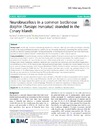Please use this identifier to cite or link to this item:
https://accedacris.ulpgc.es/jspui/handle/10553/70062
| Title: | Neurobrucellosis in a common bottlenose dolphin (Tursiops truncatus) stranded in the Canary Islands | Authors: | Sierra Pulpillo, Eva María Fernández Rodríguez, Antonio Jesús Felipe Jiménez, Idaira Del Carmen Zucca, Daniele Di Francesco, Gabriella Diaz Delgado, Josue Sacchini, Simona Rivero Santana, Miguel Antonio Arbelo Hernández, Manuel Antonio |
UNESCO Clasification: | 3105 Peces y fauna silvestre 310907 Patología |
Keywords: | Bottlenose Dolphin Brucella Canary Islands Cetacean Morbillivirus Neurobrucellosis |
Issue Date: | 2019 | Project: | Patologia Embolica (Gaseosa/Grasa) en Cetaceos (Pegcet-3) | Journal: | BMC Veterinary Research | Abstract: | Background: Brucella spp. isolation is increasingly reported in cetaceans, although associated pathologies, including lesions of the musculoskeletal and nervous systems, are less frequently described. Concerning the nervous system, Brucella sp. infection causing meningitis, meningoencephalitis or meningoencephalomyelitis have been extensively reported in striped dolphins (Stenella coeruleoalba), and less frequently in other cetacean species. Case presentation: A juvenile female common bottlenose dolphin (Tursiops truncatus) was found stranded alive in Lanzarote (Canary Islands, Spain) in 2005, but died shortly after. On physical examination, the dolphin showed a moderate body condition and was classified as code 2 (fresh dead) at the time of necropsy. The main gross findings were severe multiorgan parasitism, thickened and congested leptomeninges, and (sero)fibrino-suppurative and proliferative arthritis of the shoulder joint. Histopathological examination revealed the distinct features of a sub-acute systemic disease associated with Cetacean Morbillivirus (CeMV) infection. However, brain lesions diverged from those reported in systemic CeMV infection. This led to suspect that there was a coinfecting pathogen, based on the characteristics of the inflammatory response and the lesion distribution pattern in the central nervous system. Brucella sp. was detected in the brain tissue by PCR and Brucella antigen was demonstrated by immunohistochemistry in the brain and shoulder joint lesions. Conclusions: The zoonotic potential of marine mammal strains of Brucella has been demonstrated both in natural and laboratory conditions. In this study, PCR detected Brucella sp. in the brain of a common bottlenose dolphin stranded in the Canary Islands; the dolphin was also co-infected with CeMV. This is the first detection of Brucella sp. infection in a stranded cetacean in this archipelago. Therefore, we stress the importance of taking adequate measures during the handling of these species to prevent the transmissions of the infection to humans. | URI: | https://accedacris.ulpgc.es/handle/10553/70062 | ISSN: | 1746-6148 | DOI: | 10.1186/s12917-019-2089-0 | Source: | BMC Veterinary Research, [1746-6148], v. 15 (1), 353 |
| Appears in Collections: | Artículos |
SCOPUSTM
Citations
14
checked on Jun 8, 2025
WEB OF SCIENCETM
Citations
12
checked on Jun 8, 2025
Page view(s)
154
checked on Mar 2, 2024
Download(s)
104
checked on Mar 2, 2024
Google ScholarTM
Check
Altmetric
Share
Export metadata
Items in accedaCRIS are protected by copyright, with all rights reserved, unless otherwise indicated.
